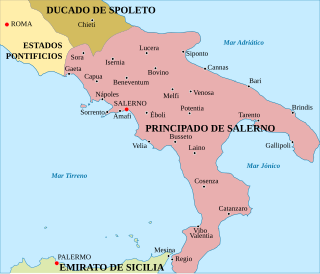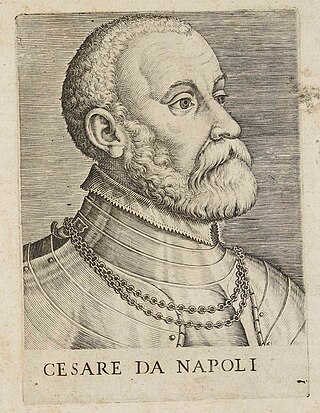Related Research Articles

Guaimar IV was Prince of Salerno (1027–1052), Duke of Amalfi (1039–1052), Duke of Gaeta (1040–1041), and Prince of Capua (1038–1047) in Southern Italy over the period from 1027 to 1052. He was an important figure in the final phase of Byzantine authority in the Mezzogiorno and the commencement of Norman power. He was, according to Amatus of Montecassino, "more courageous than his father, more generous and more courteous; indeed he possessed all the qualities a layman should have—except that he took an excessive delight in women."

Pandulf I Ironhead was the Prince of Benevento and Capua from 943 until his death. He was made Duke of Spoleto and Camerino in 967 and succeeded as Prince of Salerno in 977 or 978. He was an important nobleman in the fight with the Byzantines and Saracens for control of the Mezzogiorno in the centuries after the collapse of Lombard and Carolingian authority on the Italian Peninsula. He established himself over almost the whole of the southern half of Italia before his death in March 981. He was an ancestor of Sancho I.
Atenulf I, called the Great, was the prince of Capua from 7 January 887 and of Benevento from 899, when he conquered that principality. He also used the title princeps gentis Langobardorum: "prince of the Lombard people," an echo of the title used by the earliest prince of Benevento following the collapse of Lombard cohesion in 774.

Guaifer was the Prince of Salerno from 861. The son of Daufer the Mute and grandson of Daufer the Prophet, he was the first of the Dauferidi to sit on the Salernitan throne which his family dominated unobstructed until 977.
Landulf I, called the Old, was the first gastald of Capua of his illustrious family, which would rule Capua until 1058. According to the Cronaca della dinastia di Capua, he ruled in Old Capua for twenty five years and four months and in New Capua for another year and eight months. According to Erchempert, he was "a very bellicose man".
Landulf II (c. 825 – 879) was Bishop and Count of Capua. He was the youngest of four sons of Landulf I, gastald of Capua. As a young man, he entered the church. When his father died, his eldest brother, Lando, succeeded him.
Landulf IV was the prince of Capua and Benevento from 968, when he was associated with his father, Pandulf Ironhead, and prince of Salerno associated with his father from 977 or 978. In 968, his uncle Landulf III died, which lead to his rise, as Pandulf ignored the rights of Landulf II's son Pandulf II, his nephew, and instead associated his own son with the government.
Guy I was the Duke of Spoleto from 842. He was the son of Lambert I of Nantes and Adelaide of Lombardy, the eldest daughter of Pepin of Italy. He travelled with his father in 834 in the entourage of Lothair I. He was given the abbey of Mettlach, Lotharingia in 840, when the Emperor Louis the Pious died.
Lando I was the count of Capua from 843. He was the eldest son and successor of Landulf the Old. Like his father, he supported Siconulf against Radelchis in the civil war dividing the Principality of Benevento in the 840s.
Lando II, called Cyruttu, was the count of Capua briefly for six months in 861. He was the eldest son and successor of Lando I.
Lando III was the count of Capua for two years and ten months from 882 to his death. He was a son of Landenulf, gastald of Teano, and grandson of Landulf I of Capua.
Landenulf II succeeded his brother Landulf ΙV as Prince of Capua in 982 and ruled until his assassination. He was one of the younger sons of Pandulf Ironhead.

The Principality of Capua was a Lombard state centred on Capua in Southern Italy. Towards the end of the 10th century the Principality reached its apogee, occupying most of the Terra di Lavoro area. It was originally a gastaldate, then a county, within the principality of Salerno.

Caesar the Brave was the admiral of the fleet of the Duchy of Naples during the reigns of his father, Sergius I, and brother, Gregory III.
Pandenulf was the Count of Capua, claiming that title from 862 and holding it successfully during the tumultuous civil war of 879 – 882. He was the son and successor of Pando, but was removed on his father's death by his uncle the bishop, Landulf II.
Aloara of Capua, was a princess consort of Capua from the 960s to 981, and then co-regent of Capua jointly with her son from 982 until 992. She was said to have governed her states with great ability.
Landenulf I was briefly Count of Capua after the death of his brother Lando III in 885. He was a son of Landenulf, gastald of Teano, and grandson of Landulf I of Capua.
The Landulfids or Atenulfings were a noble family of Lombardic origin in the ninth through eleventh centuries. They were descended from Landulf I of Capua, whose own ancestry is unknown and who died in 843. The dynasty produced a line of princes which ruled most of southern Italy at one time or another and even one pope, Victor III.
Landulf of Conza, a Lombard nobleman, was briefly Prince of Benevento in 940 and then briefly Prince of Salerno in 973. The son of Atenulf II of Benevento, Landulf ruled on his father's death (940) as co-prince with his uncle, Landulf I, who soon sent him into exile. He initially took refuge at the court of Marinus II of Naples, from where he sought shelter in Salerno through his sister, Gaitelgrima, the second wife of Prince Guaimar II of Salerno. This he received and he was soon appointed gastald of Conza, while his sons—Landenulf, Landulf, Indulf, and Guaimar—were invested with land in Salerno. The Chronicon Salernitanum, which is the most important source for Landulf's life, names the counties of Marsi, Sarno, and Lauro as those of Guaimar, Indulf, and Landenulf, respectively, but does not name a county for Landulf.
References
- Erchempert. Historia Langabardorvm Beneventarnorvm at The Latin Library.
- Caserta: History, art and culture.
- Chronica S. Benedicti Casinensis at Institut für Mittelalter Forschung
- Kreutz, Barbara M. (1996). Before the Normans. Philadelphia: University of Pennsylvania. ISBN 0-8122-1587-7.